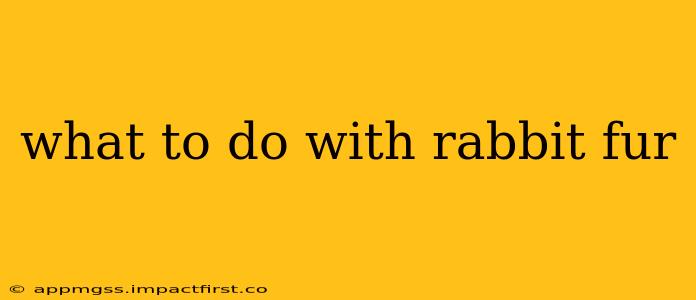Rabbit fur, once a common material in clothing and accessories, has seen a shift in public perception due to increasing awareness of animal welfare. This guide explores ethical considerations surrounding rabbit fur and offers practical ideas for utilizing it responsibly, focusing on existing materials rather than advocating for new rabbit farming.
Is it Ethical to Use Rabbit Fur?
This is a crucial first question. The ethics of using rabbit fur are complex and depend heavily on the source. Fur from rabbits raised specifically for their fur often raises ethical concerns regarding animal welfare. Factory farming practices can involve inhumane conditions, leading to stress and suffering for the animals. On the other hand, fur from rabbits that died of natural causes or were already slated for processing (e.g., as byproducts from meat production) presents a different ethical landscape. Using such materials can be seen as a form of responsible resource utilization, minimizing waste. Ultimately, the ethical decision rests on individual values and the specific origin of the fur.
What Can I Do with Rabbit Fur I Already Own?
If you already possess rabbit fur, you have several options that range from creative reuse to responsible disposal:
1. Upcycling and Repurposing:
This is the most environmentally friendly and creative approach. Rabbit fur can be incorporated into various craft projects:
- Felting: Rabbit fur is excellent for felting, creating unique items such as small toys, decorative items, or even parts of larger projects like hats or scarves.
- Patchwork: If the fur is in good condition, it can be incorporated into patchwork projects, adding a luxurious texture to quilts or other textiles.
- Trimmings and Accents: Smaller pieces of rabbit fur can be used as decorative trimmings on existing garments or accessories.
- Fur-lined garments: If you are skilled in sewing, you could use the fur to line existing coats, jackets, or gloves for added warmth.
2. Donation:
If you're unable or unwilling to repurpose the fur yourself, consider donating it to a craft organization or a school with a textiles or design program. They may have students or members who could use it for creative projects.
3. Responsible Disposal:
As a last resort, ensure proper disposal. Do not simply throw it in the trash. Check with your local waste management services for guidelines on disposing of textiles or animal products. Some communities may have specific recycling programs for textiles.
Can Rabbit Fur Be Composted?
No, rabbit fur should not be composted. It does not decompose easily in home composting systems and may attract pests. Proper disposal methods, as mentioned above, are essential.
Is Rabbit Fur Durable?
Rabbit fur's durability varies based on the type of fur and how it is processed. Generally, it is considered relatively soft and less durable than some other fur types. It is susceptible to matting and shedding if not properly cared for.
How Can I Clean Rabbit Fur?
Cleaning rabbit fur requires a gentle approach to avoid damaging the delicate fibers. Dry cleaning is generally recommended, but very gentle hand washing with a specialized fur cleaner might be possible if you're confident in your skills. Always consult a professional cleaner before attempting any cleaning method yourself.
This guide provides information on what to do with rabbit fur. Remember to prioritize ethical considerations and responsible handling throughout the process. Remember that your choices impact both the environment and animal welfare.
